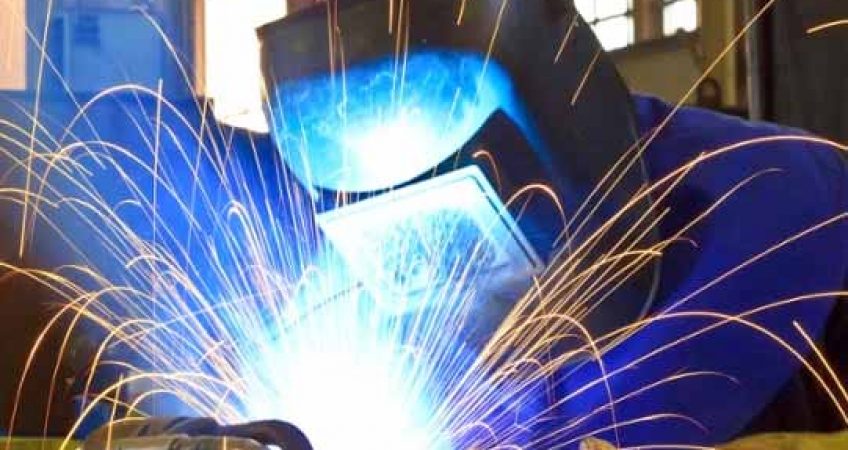10, اكتوبر 2021

mig welding
What is Metal Inert Gas mig welding?
Metal Inert Gas mig welding is an arc welding process that uses a continuous solid wire electrode heated and fed into the weld pool from a welding gun. The two base materials are melted together forming a join. The gun feeds a shielding gas alongside the electrode helping protect the weld pool from airborne contaminants.
mig welding
Metal Inert Gas mig welding was first patented in the USA in 1949 for welding aluminium. The arc and weld pool formed using a bare wire electrode was protected by helium gas, readily available at that time. From about 1952, the process became popular in the UK for welding aluminium using argon as the shielding gas, and for carbon steels using CO2. CO2 and argon-CO2 mixtures are known as metal active gas (MAG) processes. MIG is an attractive alternative to MMA, offering high deposition rates and high productivity.
Process Characteristics
mig welding is a versatile technique suitable for both thin sheet and thick section components. An arc is struck between the end of a wire electrode and the workpiece, melting both of them to form a weld pool. The wire serves as both heat source (via the arc at the wire tip) and filler metal for the mig welding joint. The wire is fed through a copper contact tube (contact tip) which conducts mig welding current into the wire. The weld pool is protected from the surrounding atmosphere by a shielding gas fed through a nozzle surrounding the wire. Shielding gas selection depends on the material being welded and the application. The wire is fed from a reel by a motor drive, and the welder moves the mig welding torch along the joint line. Wires may be solid (simple drawn wires), or cored (composites formed from a metal sheath with a powdered flux or metal filling). Consumables are generally competitively priced compared with those for other processes. The process offers high productivity, as the wire is continuously fed.
mig welding
Manual mig welding is often referred as a semi-automatic process, as the wire feed rate and arc length are controlled by the power source, but the travel speed and wire position are under manual control. The process can also be mechanised when all the process parameters are not directly controlled by a welder, but might still require manual adjustment during mig welding. When no manual intervention is needed during mig welding, the process can be referred to as automatic.
The process usually operates with the wire positively charged and connected to a power source delivering a constant voltage. Selection of wire diameter (usually between 0.6 and 1.6mm) and wire feed speed determine the mig welding current, as the burn-off rate of the wire will form an equilibrium with the feed speed.
mig welding is a common mig welding process for beginners. Learn the basics for mig welding mild steel with your MIG welder.
mig welding
Flexible solution for your fabrication and maintenance/repair needs
mig welding is an arc mig welding process in which a continuous solid wire electrode is fed through a mig welding gun and into the weld pool, joining the two base materials together. A shielding gas is also sent through the mig welding gun and protects the weld pool from contamination. In fact, MIG stands for metal inert gas. The technical name for it is gas metal arc mig welding (or GMAW), and the slang name for it is wire welding.
The
mig welding
process enables the home-hobbyist, artist, farmer/rancher, motorsports enthusiast or DIY welder to make most types of fabrication and maintenance/repair welds on material from 24-gauge up to 1/2-inch thick. In addition to flexibility, many people turn to mig welding because they've heard that it's an easy process to learn. Some claim it's no harder to use than a glue gun. While it's not quite that simple, it is true that most people can become competent MIG welders by following some basic advice.
Safety first
mig welding
Before tackling any mig welding project, you need to make sure you have the proper safety apparel and that any potential fire hazards are removed from the mig welding area. Basic mig welding safety apparel includes leather shoes or boots, cuff-less full-length pants, a flame-resistant and long-sleeve jacket, leather gloves, a mig welding helmet, safety glasses and a bandana or skull cap to protect the top of your head from sparks and spatter.
mig welding
Miller offers a wide range of safety accessories for everyone from the occasional hobbyist to the full-time professional welder. Your owner’s manual contains additional information about safety apparel and precautions.
Metal preparation
mig welding
Unlike stick and flux-cored electrodes, which have higher amounts of special additives, the solid MIG wire does not combat rust, dirt, oil or other contaminants very well. Use a metal brush or grinder and clean down to bare metal before striking an arc. Make sure your work clamp connects to clean metal, too. Any electrical impedance will affect wire feeding performance.
mig welding
To ensure strong welds on thicker metal, bevel the joint to ensure the weld fully penetrates to the base metal. This is especially important for butt joints.
mig welding
Arc welding processes are as varied as the workpieces they create, and choosing the right one is vital to your project’s success. While mig welding both form the weld using an electric arc, the techniques are quite different, and choosing the wrong one can lead to more than one headache. Read on for the reasons you may want to choose mig welding vs. tig welding